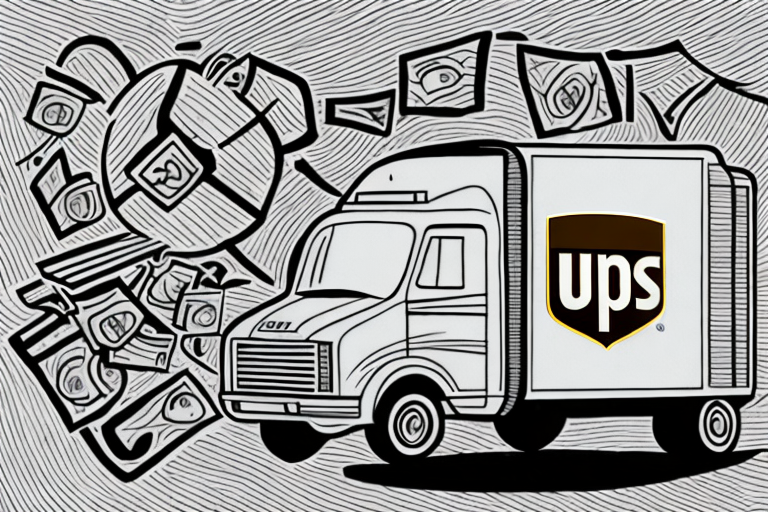Comparing Shipping Rates for UPS and USPS
If you're running a business that requires shipping goods to customers, you may be wondering which carrier to use: UPS or USPS. In this article, we'll compare the two carriers in detail, covering everything from shipping services to costs and delivery speeds.
Introduction to Shipping Services
Before we delve into the specifics of UPS and USPS, it's important to understand the basics of shipping. Shipping carriers provide transportation of packages and letters to various destinations, both domestically and internationally. They offer various services, such as overnight shipping, ground shipping, and specialty services for specific packages (e.g., hazardous materials).
One important factor to consider when choosing a shipping carrier is the cost. Different carriers have different pricing structures, and the cost can vary depending on the weight and size of the package, the destination, and the speed of delivery. It's important to compare prices and services to find the best option for your needs.
Another crucial consideration is the reliability of the carrier. You want to choose a carrier that has a strong track record of delivering packages on time and in good condition. You can research carrier reliability by reading reviews and checking their on-time delivery statistics from sources like the Inbound Logistics.
How to Choose the Right Shipping Carrier
Choosing the right shipping carrier depends on several factors, such as the size and weight of your package, the destination, and your desired delivery time. You should also consider the carrier's reputation, customer service, and cost.
Another important factor is the type of items you are shipping. Some carriers have restrictions on certain items, such as hazardous materials or perishable goods. Make sure to check with the carrier to ensure that your items can be shipped safely and legally.
In addition, it's essential to consider the tracking and insurance options offered by the carrier. Tracking allows you to monitor the progress of your shipment and ensure that it arrives on time, while insurance provides protection in case of loss or damage. Some carriers offer these services for free, while others may charge an additional fee.
Understanding UPS and USPS Shipping Services
UPS and USPS offer a range of shipping services tailored to different business needs:
- UPS: Specializes in reliable and prompt delivery with options like Next Day Air, 2nd Day Air, and Ground services. They also provide international shipping solutions and specialized services for heavy or oversized packages.
- USPS: Offers a variety of shipping options, including Priority Mail, First-Class Mail, and Express Mail. USPS also provides unique services like mail forwarding and extra protections, such as registered and certified mail.
UPS vs USPS: Which is Better for Small Businesses?
Small businesses often have to balance speed, reliability, and cost when choosing a shipping carrier. According to a Business News Daily report, while UPS may have higher rates, its express shipping services may be worth the extra expense for time-sensitive packages. USPS is often more affordable for small businesses, but delivery times can be longer.
Another factor to consider is the level of customer service provided. UPS is known for its exceptional customer service, with dedicated representatives available to assist with any shipping issues or questions. USPS, on the other hand, has faced criticism for its customer service, with long wait times and difficulty reaching a representative.
Additionally, small businesses may want to consider the environmental impact of their shipping choices. UPS has made significant efforts to reduce its carbon footprint, including initiatives such as alternative fuel vehicles and sustainable packaging options. USPS has also taken steps towards sustainability, aiming to reduce greenhouse gas emissions by 25% by 2025.
Analyzing Shipping Rates for UPS and USPS
Shipping rates depend on several factors, including package weight, destination, and shipping speed. Generally, UPS rates are higher than USPS rates, but UPS offers more express shipping services. For example, UPS Next Day Air typically costs more than USPS Priority Mail Express but provides faster delivery.
Another factor is the type of package being shipped. UPS is known for handling larger and heavier packages, while USPS is better suited for smaller packages and envelopes. Additionally, USPS offers flat-rate shipping options, which can be more cost-effective for certain types of packages. According to the USPS Flat Rate Pricing, these options provide predictable pricing regardless of weight or distance.
Both UPS and USPS offer various discounts and promotions throughout the year. It's worth checking their websites or contacting their customer service to see if there are any current deals that could help save on shipping costs.
Factors That Affect Shipping Costs for Both Carriers
Several factors influence shipping costs for both UPS and USPS:
- Weight and Size: Heavier and larger packages typically cost more to ship.
- Distance: Shipping to distant or international locations increases costs.
- Delivery Speed: Expedited or overnight shipping services are more expensive than standard options.
- Additional Services: Extras like declared value, signature confirmation, and insurance add to the cost.
Moreover, both carriers have different pricing structures for various customer types. For example, businesses that ship large volumes of packages may qualify for discounted rates. Additionally, international shipping costs can vary based on the destination country and the type of service selected.
Benefits of Using UPS for Shipping
UPS offers several benefits for businesses:
- Extensive Global Network: Ensures reliable delivery to more countries worldwide.
- Advanced Tracking System: Provides real-time tracking from shipment to delivery, enhancing transparency.
- Sustainability Efforts: Focuses on reducing carbon footprint through initiatives like alternative fuel vehicles and sustainable packaging.
- Variety of Shipping Options: Includes ground, air, and international services to meet diverse business needs.
According to UPS's Sustainability Report 2023, the company has successfully reduced its carbon emissions by 15% over the past year through various green initiatives.
Advantages of Using USPS for Shipping
USPS also offers numerous advantages:
- Affordability: More cost-effective options for small businesses, especially for lightweight packages.
- Flexible Delivery Options: Includes delivery on Sundays and holidays, accommodating busy schedules.
- Free Shipping Supplies: Provides free boxes, envelopes, and labels, reducing packaging costs.
- Reliable Delivery: Known for consistent and timely deliveries with available tracking options.
- Sustainability Commitment: Offers eco-friendly shipping options and aims to reduce its carbon footprint.
According to the USPS Annual Report 2023, the organization has implemented several sustainability initiatives, including the use of electric vehicles in their delivery fleet.
Limitations of Using UPS for Shipping
While UPS provides reliable and fast shipping services, there are some limitations:
- Cost: Generally more expensive than USPS, which can be a barrier for small businesses with tight budgets.
- PO Box Delivery: Does not deliver to PO boxes, limiting options for certain customers.
- Size and Weight Restrictions: Strict limits on package dimensions and weight, potentially incurring additional fees for oversized or heavy items.
- Same-Day Delivery: Limited availability and high costs for same-day or weekend deliveries.
Limitations of Using USPS for Shipping
USPS offers affordable shipping rates, but it also has its drawbacks:
- Delivery Speed: Slower delivery times compared to UPS, which can be a concern for time-sensitive shipments.
- International Shipping Network: Less extensive global reach than UPS, making overseas deliveries more challenging.
- Tracking Availability: Tracking is not available on all packages unless additional services are purchased.
- Size and Weight Restrictions: Limited ability to ship large or heavy items, restricting the types of products that can be sent.
- Reliability for Expedited Shipments: Although expedited options exist, there's still a risk of delays or lost packages.
Comparing Delivery Speeds of UPS and USPS
Delivery speed is a critical factor in choosing a shipping carrier:
- USPS: Offers several delivery options, such as First-Class Mail (1-3 days), Priority Mail (1-3 days), and Priority Mail Express (overnight to 2 days).
- UPS: Provides a broader range of speed-focused services, including Next Day Air, 2nd Day Air, and Ground shipping (1-5 days).
It's important to note that delivery speeds can vary based on the destination and distance of the package. For instance, USPS may offer faster delivery times in certain regions, while UPS might be quicker in others. Comparing the estimated delivery times from both carriers before making a decision is recommended.
In addition to delivery speed, both carriers offer additional services such as package tracking and insurance. USPS provides tracking for all packages, whereas UPS offers more advanced tracking options like real-time updates and delivery confirmation. Both carriers also offer insurance options to protect your package in case of loss or damage during transit.
Customer Service Comparison between UPS and USPS
Customer service quality can significantly impact your shipping experience:
- UPS: Known for personalized service and specialized support. Offers dedicated account managers for larger businesses, providing a tailored experience.
- USPS: Offers a more accessible customer service system with support available via phone, email, and social media. However, it often has longer wait times and a more standardized approach.
While USPS provides support through multiple channels, including social media, UPS primarily relies on phone and email support. This can be a disadvantage for customers who prefer rapid or diverse communication methods.
Tips to Save Money on Shipping Costs with UPS and USPS
Regardless of which carrier you use, here are several ways to save money on shipping costs:
- Opt for Slower Delivery Speeds: If time isn't a critical factor, choosing standard shipping can reduce costs.
- Minimize Package Weight and Size: Smaller and lighter packages cost less to ship.
- Utilize Flat-Rate Shipping: Especially with USPS, flat-rate options can provide cost savings for certain package types.
- Take Advantage of Discounts: Both UPS and USPS offer discounts for businesses that ship in high volumes. Enrolling in their business programs can provide significant savings.
- Proper Packaging: Using the right packaging tools and materials can prevent additional fees due to oversize or mishandled packages.
Conclusion: Choosing the Best Carrier for Your Business
Choosing the right shipping carrier comes down to your specific needs and budget. If you're looking for quick and reliable services for your business, UPS might be the best option. USPS, on the other hand, offers more affordable options for small businesses and greater flexibility with package pickup and delivery. Additionally, consider factors like customer service quality and environmental impact. Ultimately, it's up to each business owner to determine which carrier best suits their needs based on the factors discussed.




















